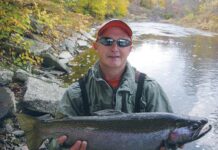Early signs of spring put smiles of anticipation on the faces of nature lovers. Longer days, warmer temperatures and lawns slowly turning from brown to green are hard to miss. But the very first harbingers of spring are more subtle.
If your daily travels take you along a stream that meanders through a wet meadow, watch for skunk cabbage as it begins to grow.
Skunk cabbage
My first memories of skunk cabbage date back to riding the school bus many years ago. Every day we passed a small wetland, and about this time of year, I noticed curious plants growing through the snow. My dad congratulated me for recognizing skunk cabbage.
At first, a sharp greenish spike pierces the ground and snow. On successive sunny days, the spikes grow rapidly and take on mottled splashes of maroon and/or yellow. The spike grows in a spiral pattern and forms a protective hood. Botanists call the hood, a highly modified leaf, the spathe.
Inside the protective cover of the spathe grows a head of small nondescript flowers called the spadix. To see the flowers requires close examination of the entrance to the spathe. You’ll probably need to get on the ground to peek inside the spathe.
Generate heat
As the spathe and spadix grow, they generate enough heat to actually melt snow and ice surrounding the plant. Rapidly growing skunk cabbage flowers can maintain a “body temperature” as much as 30 degrees F higher than ambient temperatures.
The heat is generated via oxidation by the growing flowers. This requires an unusually high rate of oxygen consumption for a plant. In fact, it’s comparable to the metabolic rate of a hummingbird. The purpose of the heat is two-fold. It produces the chemical odors that mimic decaying flesh and attract insect pollinators.
Pungent aroma
The plant’s body heat also warms the air within the flower, and this rising current carries with it the pungent aroma of the plant. Watch for a variety of tiny pollinating bees, flies and beetles attracted by the odor as they visit skunk cabbage on mild late winter days.
Walk among a patch of flowering skunk cabbage, and you’ll notice a faint skunk-like odor. Put your nose to the opening of the spathe, and the odor becomes easily recognizable.
After the flowers are pollinated, skunk cabbage fruits begin to form. The flower head swells and forms spherical balls about two inches in diameter. The heads consist of maroon-colored fruits, each containing a single seed. By late summer, the fruit’s flesh decays, and the seeds return to the soil to await germination.
Jack-in-the-pulpit, another member of the Arum family, exhibits a similar growth form, but it doesn’t emerge on forest floors until late April. Jack, the spadix, grows inside the protection of the canopied pulpit, the spathe. It grows profusely in rich bottomland soils along wooded waterways.
Skunk cabbage’s large conspicuous leaves form well after the flowers emerge. Toward the end of April, as the skunk cabbage spathe begins to wilt, a bud next to it begins to grow rapidly and unfurl. Bright green leaves unfold and suddenly skunk cabbage becomes a much more conspicuous wetland plant. In fact, its roots require year-round moisture, so it’s a plant that defines a wetland.
When I was a kid, I trapped muskrats where the skunk cabbage grew. Their runs and burrows riddled these areas.
Single seed
Skunk cabbage leaves can grow to more than 24 inches in length, so it’s hard to miss them. And when crushed, the leaves emit a distinctive skunk-like odor. By mid-June, the enormous leaves begin to decay. Left behind at the base of the decaying spathe and leaf stalks are the round maroon-colored fruits, each protecting a single seed — the source of the next generation of skunk cabbage.
Of course, not all the seeds successfully germinate. A variety of game birds including wood ducks, ruffed grouse and ring-necked pheasants eat the seeds.
Visit a skunk cabbage wetland at dusk to hear some early spring sounds. Here in western North Carolina, I’ve been hearing spring peepers since mid-January. And listen for returning killdeer (“Kill-dee! Kill-dee!”) and displaying American woodcock (Peent! Peent!”)













